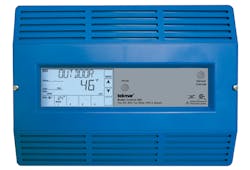Does it make any sense to install hot water boilers that are sized to match design-day ambient outdoor air temperatures? Every time they turn on, they run full-tilt as if every day is at outdoor design temperatures (coldest weather you experience based on ASHRAE guidelines).
Up front cost may be the deciding factor when presented the choice between a chimney-vented lower efficiency vs. a direct-vented high-efficiency modulating condensing boilers. Or maybe it’s the perception that the installer is working with a “high-temperature” hydronic system — like fin-tube baseboard where the operating temperature range is 160°F/180°F.
The problem with installing a boiler that matches the building’s heat loss at design-day conditions is that it is oversized for roughly 90% of the heating season. As outdoor air temperatures rise, the boiler cycles more frequently, which adversely impacts its operating efficiency because it fires to that 180°F limit virtually every time there is a call for heating.
What is outdoor reset (ODR)? ODR monitors the outdoor ambient temperature and you program the ODR control to limit the highest and lowest water temperatures. Water temperature to the heat emitters varies as necessary to make the heat output equal to the heat loss of the building.
Modulating condensing ultra-high efficiency boilers have outdoor reset on board, yet, we too often encounter ones that were installed and set to operate at their maximum water temperature and the outdoor sensor was never installed. The building owners were led to believe they were getting a 95% efficiency boiler, when, in fact, the actual operating efficiency mimics that of the lower efficiency chimney-vented boiler.
The PVC exhaust piping is often discolored due to the dry exhaust gas temperature exceeding its maximum safe temperature rating. Add the outdoor sensor, replace the PVC exhaust (never ever use foam-core PVC), and follow the installation manual to program ODR. Most will require you to select the design-day outdoor air temperature; the hottest water temperature; and the coolest water temperature. Input for warm weather shutdown (at what outdoor air temperature will you no longer need the boiler to supply heating) provides the last required input to establish the ODR curve. You don’t have to do the math.
Adding ODR to an existing lower efficiency chimney-vented boiler makes perfect “cents.” A properly adjusted reset curve will reduce your customers’ energy consumption by 10% or more. However, some after-market ODR controls require you select the turndown ratio from 2.0 to 0.2.
The Reset Ratio = (∆T supply) ÷ (∆T outdoor). ∆T supply = the required change in supply water temperature. If that’s a maximum of 140°F and minimum of 80°F, then the ∆T is 60. ∆T outdoor = the change in outdoor air temperature between zero heat loss to your design-day temperature. That might be 70°F and 0°F = a ∆T of 70. 60 ÷ 70 = .86 and that’s where you set the dial on your ODR control.
Hydronic systems utilizing cast iron baseboard and/or radiators present an ideal application for adding ODR.
Hydronic systems utilizing cast iron baseboard and/or radiators present an ideal application for adding ODR. If you take the time to do a heat loss calculation on a room-by-room basis, you can determine what water temperature will be required on your design day at 0°F. To do that, you need to determine the EDR (Equivalent Direct Radiation). See Chapter 5 of the Burnham Heating Helper at usboiler.net/library/USBoilerReport/heatinghelper/offline/download.pdf.
Next you convert the square feet of EDR to BTU output by multiplying EDR x the output per square foot using the water temperature chart on the bottom of page 71. Locate the output, based upon water temperature, that meets the room’s heat loss on the design day temperature.
The vast majority of hot water hydronic heating systems have heat emitters that are substantial over-sized and it is not uncommon to find you need 140°F or less instead of the prior 180°F being supplied. Not only will your customers be much more comfortable, their heating bills will often be dramatically lower due to utilizing ODR and because you have lowered the system’s maximum operating temperature. A rough rule-of-thumb is that for every 3°F we lower the system’s operating temperature, operating efficiency increases by 1%.
Is it feasible to utilize ODR with hydro-air systems? Absolutely! However, you will need to raise the lower limit to deliver air that will “feel” warm. Most systems will feel adequately warm with a 120°F to 130°F supply water temperature on the low side of the ODR curve.
Baseboard too! Forget the 160/180 old standard for water temperature. Here too, you can utilize the manufacturer’s technical literature to determine heat output per lineal foot of fin-tube (active) element and if there is a significant amount of bare copper enclosed in baseboard-enclosure (dummy baseboard), you can use the Burnham Heating Helper to locate the BTU per lineal foot and add that together for the net output. Match that to your room’s heat loss to determine actual required temperature on a design day, but limit the lower end to the lowest listed temperature.
You can find a rating chart at: http://www.slantfin.com/images/stories/Technical-Literature/ratings_fineline30_r.pdf. Also, here is a link to a presentation about outdoor reset curve: https://www.heatspring.com/courses/mastering-the-outdoor-reset-curve
All Dave Yates material in print and on Contractor’s Website is protected by Copyright 2016. Any reuse of this material (print or electronic) must first have the expressed written permission of Dave Yates and Contractor magazine. Please contact via e-mail at: [email protected].
About the Author
Dave Yates
Dave Yates material in print and on Contractor’s Website is protected by Copyright 2017. Any reuse of this material (print or electronic) must first have the expressed written permission of Dave Yates and Contractor magazine.
